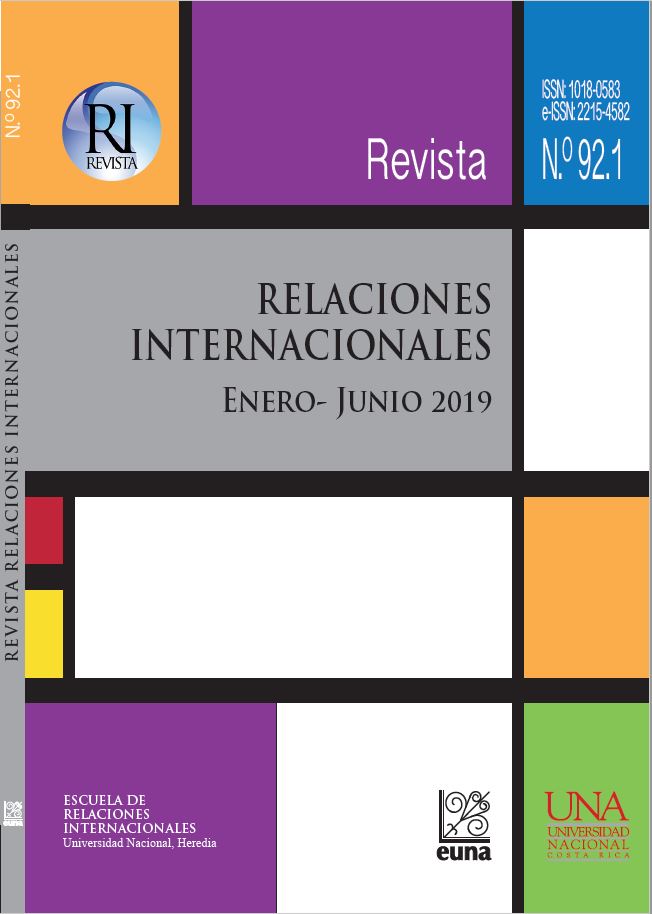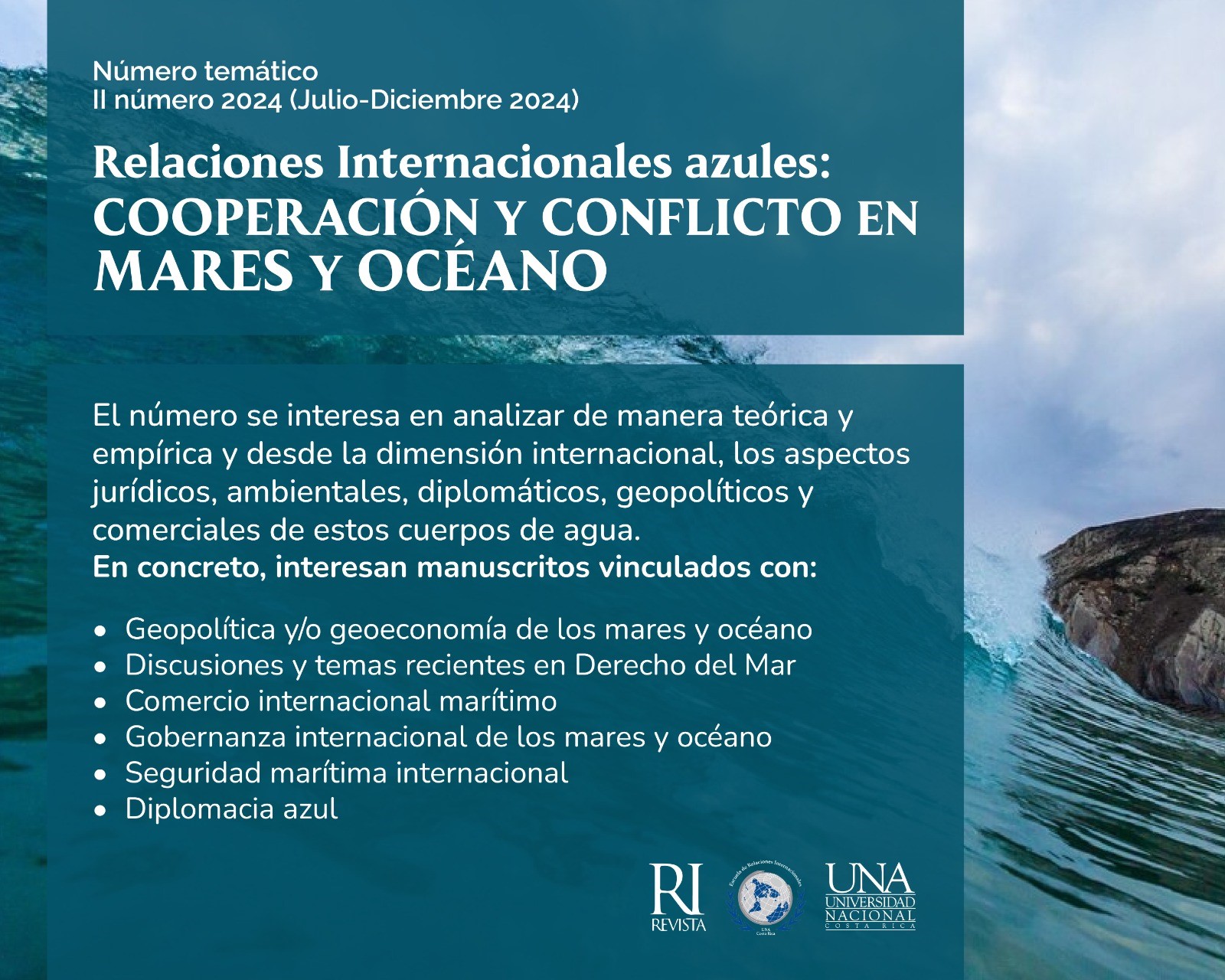Alianzas estratégicas: ¿Herramientas para gestionar las políticas exteriores latinoamericanas o estrategias discursivas?
DOI:
https://doi.org/10.15359/ri.92-1.4Palabras clave:
Alianzas estratégicas, América Latina, Discusión Conceptual, Teoría de las Relaciones Internacionales, Política Exterior, Estrategia discursivaResumen
This paper focuses on discussing and analyzing strategic alliances in order to understand whether they are a foreign policy option for Latin American States or just a discursive strategy. The main objective is to attain a better understanding of strategic alliances with respect to their main goals and expectations, analyzing whether they are short or long-term options, and evaluating how many strategic alliances a single country is able to develop. The central argument is that, in many cases, although Latin American leaders state the existence of strategic partnerships in their mutual relations, there is still a gap between discourse and practice. This situation implies the risk of removing the concept of the content.
Referencias
Andrews, K. (1971). The concepts of corporate strategy. Homewood: Dow Jones-Irwin.
Ansoff, H. I. (1965). Corporate strategy. New York: McGraw Hill.
Aron, R. (1963). Paz y Guerra entre las Naciones. [Peace and War: A Theory of International Relations]. Madrid: Revista de Occidente.
Bleeke, J. A & Ernst, D. R. (1993). Collaborating to Compete: Using Strategic Alliances and Acquisitions in the Global Marketplace. New York: John Wiley and Sons.
Bull, H. (1977). The Anarchical Society. A Study of Order in World Politics. New York: Columbia University Press.
Chandler, A. D. (1962). Strategy and Structure. Cambridge: MIT Press.
Chung, S., Singh, H., & Lee, K. (2000). Complementarity, status similarity and social capital as drivers of alliance formation. Strategic Management Journal. 21, 1–22.
Cummings, T. (1984). Transorganizational Development. Research in Organizational Behavior. 6, 367-422.
Das, T. K. (2006). Strategic Alliances Temporalities and Partner Opportunism. British Journal of Management. 17, 1-21.
Das, T. K. & Teng, B. (2000). A Resource-Based Theory of Strategic Alliances. Journal of Management. 26 (1), 31-61.
Das, T. K. & Teng, B. (2002). The Dynamics of Alliance Conditions in the Alliance Development Process. Journal of Management Studies. 39 (5), 726-746.
Deutsch, K. (1974). The Analysis of International Relations. New Jersey: Prentice Hall.
Escudé, C. (1991). La política exterior de Menem y su sustento teórico implícito. América Latina/Internacional. 8 (27), 394-406.
Gilpin, R. (2001). Global Political Economy. Princeton: Princeton University Press.
Grant, R. & Baden-Fuller, C. (2004). A Knowledge Accessing Theory of Strategic Alliances. Journal of Management Studies. 41 (1), 61-83.
Gulati, R. (1995). Does Familiarity Breed Trust? The Implications of Repeated Ties for Contractual Choice in Alliances. Academy of Management Journal. (38), 85-112.
Hagedoorn, J. & Duysters, G. (2002). External Sources of Innovative Capabilities: The Preference for Strategic Alliances or Mergers or Acquisitions. Journal of Management Studies. 39 (2), 165-188.
Halliday, F. (2006). Las Relaciones Internacionales y sus debates. Madrid: Centro de Investigación para Paz.
Harrigan, K. (1988). Strategic Alliances and Partner Asymmetries. In Contractor, F. J. & Lorange, P., eds. Cooperative Strategies in International Business. Lexington: Lexington Books.
Ikenberry, G. J. (2000). After Victory. Institutions, Strategic Restraint and the Rebuilding of Order after Major Wars. Princeton: Princeton University Press.
Johansson, J. (1995). International Alliances: Why Now? Journal of the Academy of Marketing Science. 33 (4), 301-304.
Kang, N. & Sakai, K. (2000). International Strategic Alliances. The Role in industrial globalization. OCDE Science, Technology and Industry Working Paper. 5, 1-49.
Keohane, R. (1988). Después de la hegemonía. Cooperación y discordia en la política económica mundial. Buenos Aires: Grupo Editor Latinoamericano.
Keohane, R. & Nye, J. (1988). Poder e interdependencia. Buenos Aires: Grupo Editor Latinoamericano.
Krauthammer, C. (1990/1991). The Unipolar Moment. Foreign Affairs. 70 (1), 23-33.
Kumar, R. & Das, T. K. (2007). Interpartener Legitimacy in the Alliance Formation Process. Journal of Management Studies. 44 (8), 1425-1453.
Levine, J. & Byrne, J. (1986). Corporate Odd Couples. Business Week. July 21: 100-105.
Liska, G. (1968). Nations in Alliance. The Limits of Interdependence. Baltimore: The John Hopkins Press.
McGee, J. E., Dowling, M. J., & Megginson, W. L. (1995). Cooperative Strategy and New Venture Performance: The Role of Business Strategy and Management Experience. Strategic Management Journal. 16, 565–580.
Mohr, J. & Spekman, R. (1994). Characteristics of Partnership Success: Partnership Attribute, Communications Behavior, and Conflict Resolution. Strategic Management Journal. (15), 135-152.
Morgenthau, H. (1948). Politics Among Nations. The Struggle for Power and Peace. New York: A. A. Knopf.
Morrow, J. (1991). Alliances and Asymmetry: An Alternative to Capability Aggregation Model of Alliances. American Journal of Political Science. 35 (4), 904-933.
Ohmae, K. (1989). The Global Logic of Strategic Alliances. Harvard Business Review. 67 (2), 143-152.
Parkhe, A. (1993). Strategic Alliance Structuring: A Game Theoretic and Transaction Cost Examination of Interfirm Cooperation. Academy of Management Journal. 36, pp. 794–829.
Porter, M. (1979). The Structure within Industries and Companies’ Performance. Review of Economics and Statistics. (61), 214–228.
Porter, M. (1980). Competitive strategy. New York: Free Press.
Porter, M. (1981). The Contribution of Industrial Organization to Strategic Management. Academy of Management Review. (6), 609–620.
Porter, M. (1985). Competitive Advantage. New York: Free Press.
Porter, M. (1991). Towards a Dynamic Theory of Strategy. Strategic Management Journal, (12) Special Issue, 95–117.
Porter, M. (1996). What is Strategy? Harvard Business Review. 74 (6), 61–78
Rosencrance, R. (1986). The Rise of Trading States. Commerce and Conquest in the Modern World. New York: Basic Books.
Spekman, R., Forbes, T., Lynn, I. & MacAvoy, T. (1998). Alliance Management: A view from the Past and Look to the Future. Journal of Management Studies. 35 (6), 747-772.
Strange, S. (1970). International Economics and International Relations: A Case of Mutual Neglect. International Affairs. 46 (2), 304-315.
Varadarajan, P. R. & Cunningham, M. (1995). Strategic Alliances: A Synthesis of Conceptual Foundations. Journal of Academy of Marketing Science. 3 (24), 282-296.
Vásquez, J. (1994). El Pensamiento de los clásicos. Mexico D. F.: Limusa.
Walt, S. (1987). The Origins of Alliances. Ithaca-New York: Cornell University Press.
Walt, S. (1989). Alliances in Theory and Practice: What lies ahead? Journal of International Affairs. 43 (1), 1-17.
Walt, S. (2005). Taming American Power: The Global Response to U. S. Primacy. New York-London: W. W. Norton.
Waltz, K. (1988) Teoría de la política internacional. Buenos Aires: Grupo Editor Latinoamericano.
Wendt, A. (1999). Social Theory of International Politics. Cambridge (UK): Cambridge University Press.
Wohlforth, W. (1999). The Stability of a Unipolar World. International Security. 24 (1), 5-41.
Descargas
Publicado
Cómo citar
Número
Sección
Licencia
Esta publicación está adscrita a Creative Commons; deben respetarse sus atribuciones y restricciones.
Los autores/as que publiquen en esta revista aceptan las siguientes condiciones:
- Los autores/as conservan los derechos de autor y ceden a la revista el derecho de la primera publicación, con el trabajo registrado con la Licencia Creative Commons Atribución-NoComercial-CompartirIgual 4.0 Internacional, que permite a terceros utilizar lo publicado siempre que mencionen la autoría del trabajo y a la primera publicación en esta revista.
- Los autores/as pueden realizar otros acuerdos contractuales independientes y adicionales para la distribución no exclusiva de la versión del artículo publicado en esta revista (p. ej., incluirlo en un repositorio institucional o publicarlo en un libro) siempre que indiquen claramente que el trabajo se publicó por primera vez en esta revista.
- Se permite y recomienda a los autores/as a publicar su trabajo en Internet (por ejemplo en páginas institucionales o personales) antes y durante el proceso de revisión y publicación, ya que puede conducir a intercambios productivos y a una mayor y más rápida difusión del trabajo publicado.
Revista de Relaciones Internacionales por Universidad Nacional de Costa Rica está bajo una Licencia Creative Commons Atribución-NoComercial-SinDerivar 4.0 Internacional









.png)



2.png)
